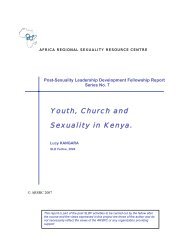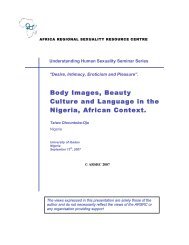Sexuality in Media: Emerging Issues in Africa - Africa Regional ...
Sexuality in Media: Emerging Issues in Africa - Africa Regional ...
Sexuality in Media: Emerging Issues in Africa - Africa Regional ...
Create successful ePaper yourself
Turn your PDF publications into a flip-book with our unique Google optimized e-Paper software.
<strong>Sexuality</strong> <strong>in</strong> the <strong>Media</strong>: Emerg<strong>in</strong>g <strong>Issues</strong> <strong>in</strong> <strong>Africa</strong><br />
References<br />
Action Health Incorporated (2003) Comprehensive <strong>Sexuality</strong> Education:<br />
Tra<strong>in</strong>ers' Resource Manual, Lagos: Action Health Inc.<br />
Government of Kenya (2003), The Children Act 2002, Government Pr<strong>in</strong>ters,<br />
Nairobi<br />
Herbert, J. (2001). Practic<strong>in</strong>g Global Journalism. Oxford: Focal Press.<br />
NCPD (1996). National Population Advocacy and IEC Strategy for<br />
Susta<strong>in</strong>able Development 1996-2001.Nairobi: National Council for<br />
Population and Development.<br />
NCPD (2000). Sessional Paper No.1 of 2000 on National Population Policy<br />
for Susta<strong>in</strong>able Development. Nairobi: National Council for Population and<br />
Development.<br />
Odero, M. and E. Kamweru (2000). <strong>Media</strong> Culture and Performance <strong>in</strong><br />
Kenya. Nairobi: Institute of Mass Communication<br />
Odhiambo, L. (2000). Mass <strong>Media</strong> and the AIDS Pandemic <strong>in</strong> Kenya 1997-<br />
1998- A Moral Panic Perspective <strong>in</strong> Baofo K. S. T. and Carlos A. Amaldo<br />
(2000).<br />
Wikipedia (2002), the Free Encuclopaedia. Free software Foundation Inc.<br />
Boston, USA.<br />
Newspapers and Magaz<strong>in</strong>es<br />
st th<br />
All Nation Newspapers 1 January-30 June 2004<br />
th<br />
All East <strong>Africa</strong>n Standard Newspapers 1st January-30 June 2004<br />
th<br />
All Kenya Times Newspapers 1st January-30 June 2004<br />
th<br />
All People Newspapers 1st January-30 June 2004<br />
Parents Magaz<strong>in</strong>e publications -March, April and May<br />
The Insyder Magaz<strong>in</strong>e Publications -January, February, May and June<br />
Introduction<br />
Exposure to the <strong>Media</strong> <strong>in</strong> Egypt<br />
In addition to the classic function of <strong>in</strong>form<strong>in</strong>g the general population, <strong>in</strong><br />
many countries the media play a vital role <strong>in</strong> draw<strong>in</strong>g the attention of<br />
programme managers and policy makers to the strengths and weaknesses of<br />
the programmes by publish<strong>in</strong>g critical reviews on program performance,<br />
identify<strong>in</strong>g potential problems, and highlight<strong>in</strong>g successes (Hegazi and<br />
Khalifa, 2000). Several studies <strong>in</strong> Egypt show that literate men and women<br />
have the habit of read<strong>in</strong>g newspapers and magaz<strong>in</strong>es (Hegazi and Khalifa,<br />
2000).<br />
The 2003 EDHS collected <strong>in</strong>formation on the exposure of women to various<br />
mass media <strong>in</strong>clud<strong>in</strong>g television, radio, and pr<strong>in</strong>t media (i.e. magaz<strong>in</strong>es and<br />
newspapers). These data are important for design<strong>in</strong>g media <strong>in</strong>terventions.<br />
Table (1) Percentage Distribution of the Participants by their Exposure to the <strong>Media</strong><br />
Watch T.V. Weekly<br />
Type of <strong>Media</strong> Percent of those who are exposed<br />
Listen to the Radio Weekly<br />
Read Newspapers/Magaz<strong>in</strong>es<br />
All three <strong>Media</strong><br />
No <strong>Media</strong> Exposure<br />
92.9<br />
63.5<br />
20.9<br />
16.2<br />
4.8<br />
Source: Adapted from EDHS (2003) table 1.11 page 14<br />
Table (1) Shows that pr<strong>in</strong>t materials are the least of the three major media<br />
sources. Among those who are exposed to the pr<strong>in</strong>t media, it seems that<br />
residence, education and work status are major determ<strong>in</strong><strong>in</strong>g factors (see Table<br />
2).






